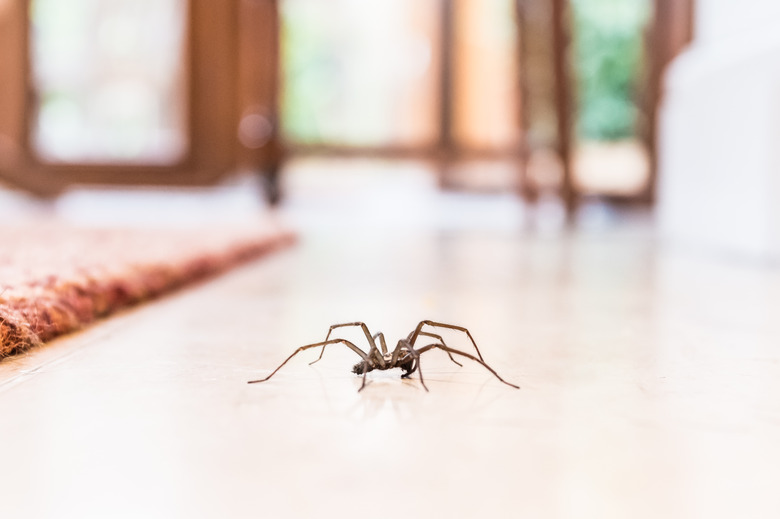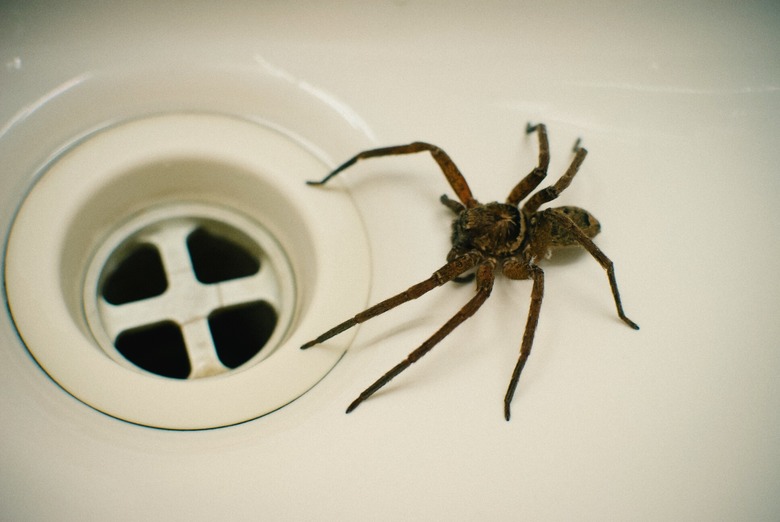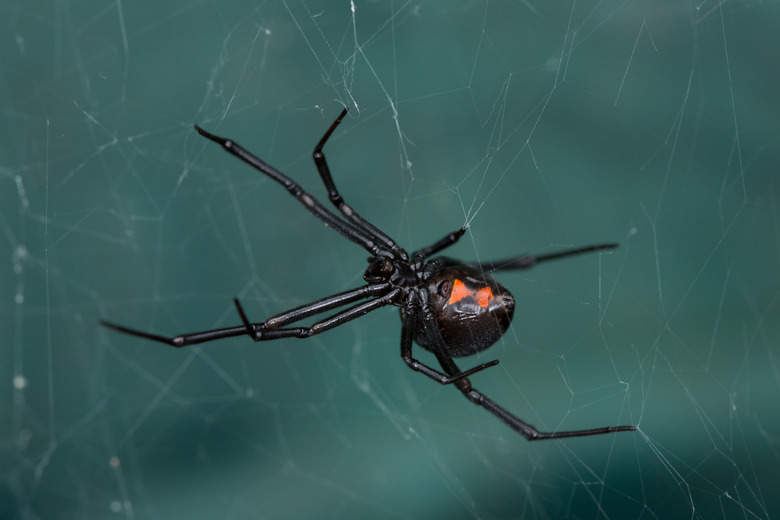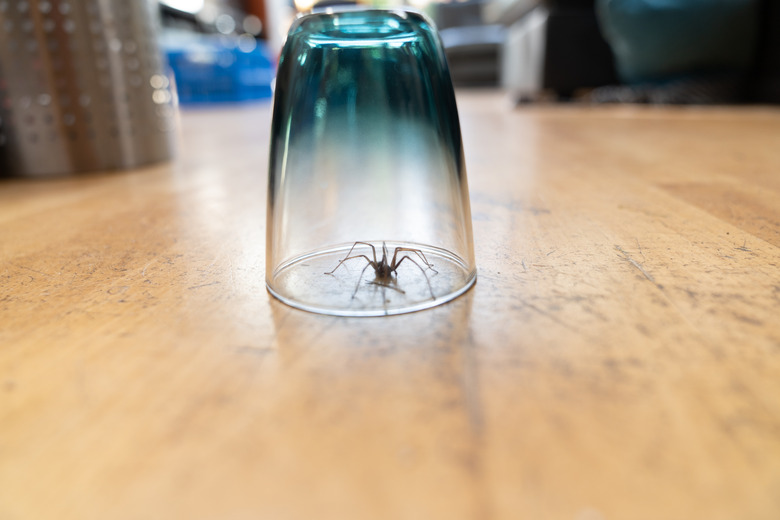How To Get Rid Of Spiders
We may receive a commission on purchases made from links.
If you're wondering how to get rid of spiders, it may be because you're among the 5 percent of Americans who suffer from arachnophobia — the fear of spiders — or it may simply be because you're tired of cleaning webs from your ceilings and walls. Besides these two motivations for spider control, there's one more: You're afraid of being bitten. Some spiders are indeed dangerous, but on the whole, you should put that fear to rest.
Only two species of North American spiders — black widow and brown recluse spiders— have dangerous bites, and if one of these is in your house, you're unlikely to see it. Both species prefer dark, out-of-the-way places, like basements, crawl spaces, and dark cupboards. That doesn't make them any less dangerous, but your pest control efforts are wasted on something you can't see. Most of the spiders you can see are harmless, and although some may bite when provoked, the effects of most spider bites are comparable to bites from mosquitoes, fleas, or ticks, which are far more dangerous critters because they spread disease.
Spiders are solitary creatures, and the presence of one or several does not indicate the existence of a colony, so far-reaching pest control methods that include the use of pesticides are seldom needed. In most cases, the best course of action is to simply move the spider outside; there's no need to kill it. Spiders get a bad rap simply because they just look so creepy, but they are beneficial creatures that help keep insect populations down, so they deserve some respect.
What Do Spiders Look Like?
What Do Spiders Look Like?
- Species name: Class Arachnida, Orders Araneae (spiders); Opiliones (daddy longlegs). There are over 40,000 spider species worldwide.
- Physical characteristics: Spiders
vary in length from a few millimeters to several inches. All species
have eight legs and segmented bodies divided into two sections. - Wings or wingless? Spiders
do not have wings, but they all produce silk, and some use this silk as
a sail to move around on the wind. This is called ballooning.
- Species varieties: Black widow spiders (genus Latrodectus) are about 1 1/2 inches long and have bulbous, shiny black bodies with a red hourglass on the abdomen. Brown recluse spiders (Loxosceles reclusa)
are about 3/8 inch long with a uniform cream-colored or brown body and a
violin shape on the thorax. They are often referred to as fiddleback spiders. - How to tell lookalikes apart: Although daddy longlegs belong to a different order than spiders, they look and
behave the same, although they don't spin webs and prefer to attack and
catch their prey live. They are easy to distinguish because of their
very long, jointed legs that extend to a radius of as much as 2 inches
and carry the 3/8-inch-long, peanut-shaped body like a pod. Also
known as harvestman spiders, they are venomous, but their fangs are too
short to pierce human skin.
How to Get Rid of Spiders
How to Get Rid of Spiders
The use of an insecticide to get rid of spiders won't be effective unless you spray it directly on one, and even then, spraying insecticide needlessly spreads toxins through your home. Insecticides for spiders usually contain pyrethrins, a chemical derived from chrysanthemums, and pyrethroids, which are synthetic compounds. While pyrethrins are considered to be of low toxicity to humans, they can cause allergic reactions in sensitive people. Pyrethroids are more toxic and can linger for up to 10 days.
It's much more effective to simply squash the spider with your shoe or a rolled-up newspaper, but considering the usefulness of these creatures for controlling insect populations, you might want to simply trap it under a jar, cover the mouth of the jar with a sheet of paper, and take the spider outside. That isn't always an option when you see one crawling on the ceiling or if you're squeamish about spiders, but there are other simple tricks for removing spiders without killing them.
Vacuum Them Up
The fastest way to eliminate spiders from your house is to vacuum them up, web and all. Spiders are small and don't have enough tackiness on their feet to resist the suction, and the impact of the vacuum usually crushes their bodies against the vacuum hose. If you want to spare the little creatures, consider purchasing a spider-safe vacuum, such as the BugZooka, which has a straight barrel that deposits bugs safely in a removable canister so you can release them outside. This Dyson vacuum is a straight-barreled, battery-powered vacuum that can be used for this purpose, and it does a great job on floors too.
Use a Low-Toxicity Spray
If spraying is your preferred method for controlling a spider infestation, consider a low-toxicity spray instead of an insecticide. Fill a spray bottle with a bleach solution or one made with vinegar; both can kill spiders and can also be used as a spider repellent when sprayed in crevices or around baseboards and windowsills where spiders tend to come into the room and set up shop. Glue traps are an easy to use alternative to spraying. They are small cardboard boxes with a sticky bottom into which spiders can enter but never leave. Glue traps are inexpensive, so you can replace them often, and they are sanitary.
Use Essential Oils to Keep Dangerous Spiders Away
The spiders you legitimately need to fear — black widows and brown recluses — prefer out of the way places, like basements, crawl spaces, and the underside of furniture. You can spray essential oils like peppermint and eucalyptus as well as vinegar or bleach to keep them away. You can also cover specific areas with drops of peppermint oil, and you can deploy spider traps.
Be Cautious in Dark Areas — And When Opening Packages
If you're entering a dark area that hasn't been protected, you have to be careful. Your best bet is to get a flashlight and vacuum cleaner before you enter and be prepared to use the vacuum. Be extra careful when opening shipping parcels and cardboard boxes because these spiders frequently hide inside them, which is often how they get into your house in the first place. Have a vacuum handy so you can suck up any spiders you see when opening parcels.
When to Hire a Pro
When to Hire a Pro
Keeping in mind that most spiders are beneficial even if they are an annoyance, calling an exterminator to get rid of them is a drastic measure. Pest control companies do handle spiders, though, usually first identifying them before using basically the same measures homeowners use but in a more targeted and efficient way. Costs range from $150 to $300, and many companies consider removal of black widows and brown recluses a premium service and charge more for them.
Getting Rid of Spiders Naturally
Getting Rid of Spiders Naturally
If you're looking for more natural ways to keep spiders from ruining your afternoon, there are plenty you can try:
- Clean
your house regularly with a vacuum cleaner, paying special attention to
upholstery and the underside of chairs, sofas, and beds.
- Clear
up clutter inside and outside of your home to deprive spiders of hiding
places. Move debris away from the sides of your house and trim
overhanging tree branches that spiders can use as bridges onto the roof
to gain access to the attic.
- Spread diatomaceous earth
around the perimeter of your home and around the baseboards inside. It lacerates their bodies, so spiders avoid walking through it.
- Place cedar balls around the house, in drawers and cabinets, and in the basement or crawl space. The natural oils in cedarwood are a natural spider repellent, and they'll also keep cockroaches away.
- Eliminate
food sources by keeping doors and windows closed so flies, mosquitoes,
and other spider prey don't fly into the house. Turn off the outdoor
lights at night so flying insects aren't attracted to your home.
- Clean up debris in the garden. Spiders thrive in gardens overrun with dense foliage and dead plants.
- Get a cat — or a frog. Both are natural spider predators.
How Quickly Can You Get Rid of Spiders?
How Quickly Can You Get Rid of Spiders?
Physical removal of spiders offers instant gratification, but the chances are slim to none that you'll be able to find all the spiders in your house and get rid of them this way. If you see one spider, it's almost a sure bet that there is at least one egg sac somewhere, and if it hasn't already hatched, it won't be long before it does, which means the addition of hundreds of spiderlings — which will become adults in a year — in your household.
Even if it's fast and easy to remove or kill spiders you see, that isn't how to get rid of spiders in the rest of the house. Removal of those you don't see is an elusive goal requiring constant vigilance on your part. Your best bet may be to use products that repel spiders to keep them away from certain areas of the house.
How Spiders Get In Your House
How Spiders Get In Your House
The majority of the spiders you see in the house were born there. If one female can produce hundreds of offspring, it isn't hard to figure out that there will be many more once the offspring begin breeding. Not all offspring survive, of course, but the population can increase exponentially if even a small number survive each hatching, which occurs about two to three weeks after the female lays an egg sac.
That begs the question of how the original spider that spawned the population got there. They might have crawled along the ground to the foundation and entered through a gap in the wall or swung onto the siding from a nearby tree like Tarzan, but most likely, they came in on your clothes or something you brought inside, such as parcels, firewood, plants, camping equipment, lawn furniture, or toys. Spiders aren't seasonal, but they prefer warmth, so they are less likely to come into the house during the winter, but once in the house where's it's always warm, they are active all year.
How to Prevent Spiders
How to Prevent Spiders
Just as for other pest infestations, such as cockroaches and ants, one of the most often recommended spider control strategies is sealing crevices and holes around the house with caulk to prevent them from coming in. The problem with this approach is that only 5 percent of spiders have ever been outside in the first place. Female house spiders lay egg sacs, each containing hundreds of individuals that hatch fully formed and take about a year to mature into adulthood. Sealing your house can't hurt, though, and it will help keep other pests away.
A 2018 study found that peppermint and chestnuts are both effective for repelling spiders, so spraying peppermint oil or placing chestnuts (sometimes called conkers) in strategic places can help keep spiders away from those places. Some sources caution that chestnuts shouldn't be placed where pets can get to them, but they are nontoxic to both dogs and cats, although you probably shouldn't let your pet have too many of them.
Do Spiders Cause Damage or Spread Disease?
Do Spiders Cause Damage or Spread Disease?
Unless your definition of disease includes being injected with venom — which is highly unlikely — spiders don't spread disease. In fact, they help prevent the spread of disease in your home by eating insects that actually do carry disease-causing pathogens, like mosquitoes, fleas, flies, and cockroaches.
Spiders are also beneficial in the garden, eating flies, gnats, and insect larvae that would otherwise dine on leaves. They also eat pollinators, so bees stay away when spiders are present, which hinders the reproductive cycle. As far as plants are concerned, however, they actually seem to want the spiders around. Some flowering plants secrete a scent that attracts crab spiders when they are under attack, a phenomenon that can be interpreted as a cry for help. Apparently, it works.
References
- Country Living: How to Get Rid of Spiders: 18 Natural Ways to Keep Spiders Out of Your House
- The Home Depot: How to Get Rid of Spiders
- University of California Statewide Integrated Pest Management Program: Spiders
- Harlequin's Gardens: Pyrethrum Insecticides: Are They Safe?
- Expert Home Tips: How To Get Rid Of Spiders (17 Easy Tips That Really Work!)
- Psycom: Arachnophobia: Fear of Spiders and How to Overcome It
- National Library of Medicine: Natural Compounds as Spider Repellents: Fact or Myth?
- merican Society for the Prevention of Cruelty to Animals: Chestnut
- Science Daily: How Spiders Can Harm and Help Flowering Plants



